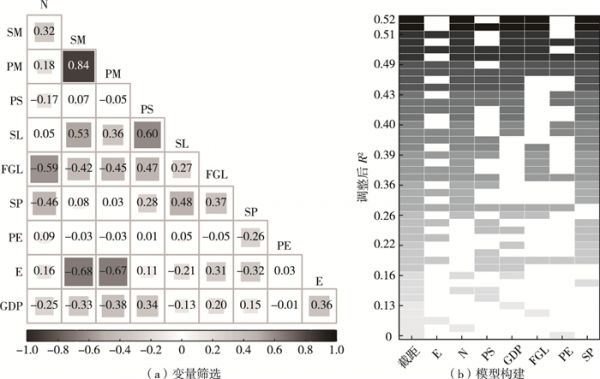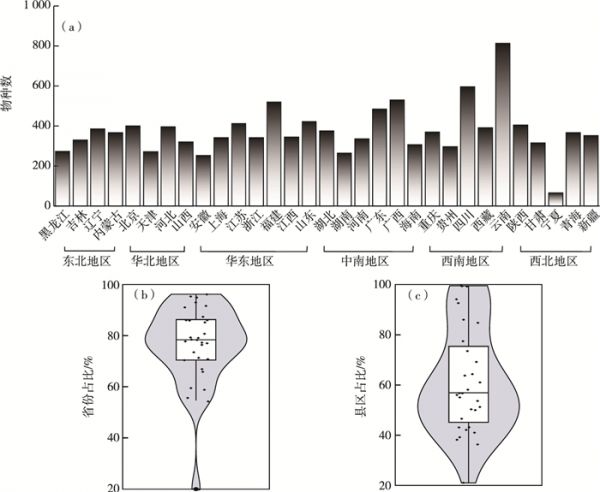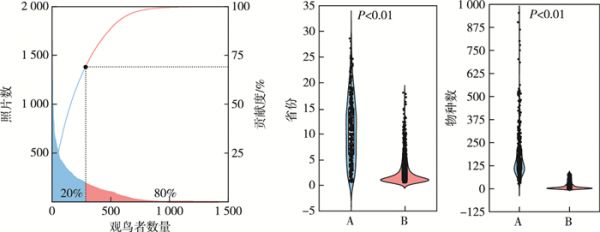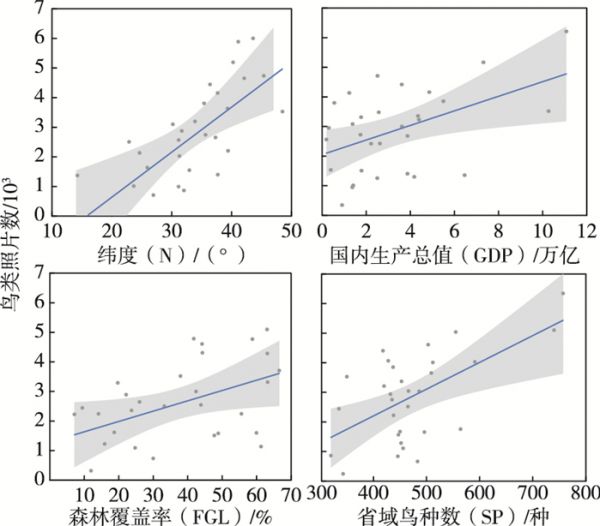公众科学对中国鸟类物种多样性研究的贡献: 基于“鸟网”图库数据计量
摘要:
公民科学能从广阔的时空尺度中获得丰富的物种信息,在生物多样性监测与持续变化研究中显得越来越重要,对全球生物多样性指标量化起到至关重要的作用。为了解中国各省份鸟种记录现状、公众贡献力、受限因素以及未来变化趋势变化,系统检索和提取了“鸟网”的鸟类照片信息,整理了各省份鸟种数与公众贡献力情况,采用累积曲线和多元线性回归方法了解公众参与数量与贡献力现状及未来变化趋势,分析了公众贡献力的相关影响因素。结果表明:具有地理信息记录的鸟类共计1 310种。在省级行政区划上,云南省鸟种记录最为丰富(813),宁夏回族自治区鸟种记录最为匮乏(65)。在地理区域上,西南地区鸟种记录丰富度最高,各省份平均记录493种;西北地区鸟种记录丰富度最低,各省份平均记录300种。通过80/20定律分割,在照片数、记录地点和物种贡献度上,前20%观鸟者远远高于后80%观鸟者,前20%观鸟者贡献的照片数量是后者的2.2倍,占照片总数的68.98%。累积曲线显示,2018年后鸟种记录变为一条渐近线,表明鸟种数接近饱和,已记录到绝大部分中国鸟类。随时间累积观鸟者数量持续增长,未来会不断有新观鸟者加入,并且新涉足乡镇会持续增加。各省份鸟类照片数与纬度、国内生产总值(GDP)、森林覆盖率和鸟种数呈显著正相关,其中地区鸟种数是吸引观鸟者拍摄记录的主要因素。总体上,公民科学在提供关于中国鸟类物种多样性和地理分布数据方面起到重要作用,随着公众参与数量和贡献力的持续上升,未来将有更多公众为我国鸟类学相关研究提供分布数据。
关键词: 鸟类 / 公民科学 / 物种多样性Abstract:
Citizen science (CS) generates much information over wide geographical areas and extended time scales. CS has grown increasingly important in biodiversity monitoring and sustainable change research, where it is critical in assessing global biodiversity indicators and achieving the United Nations′ sustainable development goals. This study systematically collected photographic information submitted to BirdNET (http://www.birdnet.cn) concerning birds spotted in Chinese provinces. The goals were to (1) determine the number and diversity of birds recorded by the public in each province, (2) comprehend the scope of public contributions, (3) forecast future trends in public contributions, and (4) understand the limiting factors that affect public participation. The number of species and public contributions were collated by province. Cumulative curves and multiple linear regression were used to analyze participation, contributions, future trends, and relevant factors. There were 1 310 species of birds identified using geographical information. At the provincial level, Yunnan Province had the most diverse species (813), and the Ningxia Hui Autonomous Region had the fewest (65). Geographically, the highest number of species was observed in the southwest, with an average of 493 species per province. The lowest number was observed in the northwest, averaging 300 per province. Applying the 80/20 law, the 20% high-ranking bird watchers provided much more photographs, locations, and species contributions than the other 80% (for example, contributing 68.98% of all photographs). The cumulative curve of species observations neared the asymptote after 2018, indicating that the record is close to saturation (the vast majority of Chinese birds have been recorded). The number of bird watchers will continue to increase as more individuals participate and the number of locations increases. The contributions of bird watchers are significantly and positively correlated with the latitude, GDP, forest coverage, and bird species diversity of the provinces. The local species diversity is the main factor attracting bird watchers. Despite the late start and low level of participation in bird-watching activities in China, the number of participants continues to rise, providing increasing amounts of data for ornithological studies that will play an important role in understanding bird species composition and population distribution in China.

图 1 多元线性回归模型的变量筛选与模型构建
E为经度;SM为省域面积;PM为保护区面积;PS为保护地数量;SL为森林面积;FGL为森林覆盖率;SP为省域鸟种数;PE为人口数;N为纬度;GDP为国内生产总值。
Figure 1. Variable screening and model construction of multiple linear regression model

图 2 各省份鸟类物种数和占比
Figure 2. Number and proportion of bird species in each province

图 3 观鸟者对鸟类物种多样性调查的贡献度
A指贡献度为前20%的观鸟者;B指贡献度为后80%的观鸟者。
Figure 3. Contribution of birdwatchers to the survey on bird species diversity

图 4 乡镇记录点、观鸟者和鸟类物种的时间累积曲线
Figure 4. Time cumulative curves of township record points, photographers, and bird species

图 5 省域鸟类照片数的影响因素
Figure 5. Factors affecting the number of bird photos in the provinces
[1]SILVERTOWN J. A New Dawn for Citizen Science[J]. Trends in Ecology & Evolution, 2009, 24(9): 467-471.
[2]SCHMELLER D S, HENRY P Y, JULLIARD R, et al. Advantages of Volunteer-based Biodiversity Monitoring in Europe[J]. Conservation Biology, 2009, 23(2): 307-316. DOI: 10.1111/j.1523-1739.2008.01125.x
[3]DICKINSON J L, ZUCKERBERG B, BONTER D N. Citizen Science as an Ecological Research Tool: Challenges and Benefits[J]. Annual Review of Ecology, Evolution, and Systematics, 2010, 41: 149-172. DOI: 10.1146/annurev-ecolsys-102209-144636
[4]CHANDLER M, SEE L D, BUESCHING C D, et al. Involving Citizen Scientists in Biodiversity Observation[M]//The GEO Handbook on Biodiversity Observation Networks. Cham: Springer, 2017: 211-237.
[5]SULLIVAN B L, AYCRIGG J L, BARRY J H, et al. The eBird Enterprise: An Integrated Approach to Development and Application of Citizen Science[J]. Biological Conservation, 2014, 169: 31-40. DOI: 10.1016/j.biocon.2013.11.003
[6] 张健, 陈圣宾, 陈彬, 等. 公众科学: 整合科学研究、生态保护和公众参与[J]. 生物多样性, 2013, 21(6): 738-749. https://www.cnki.com.cn/Article/CJFDTOTAL-SWDY201306013.htmZHANG Jian, CHEN Sheng-bin, CHEN Bin, et al. Citizen Science: Integrating Scientific Research, Ecological Conservation and Public Participation[J]. Biodiversity Science, 2013, 21(6): 738-749. https://www.cnki.com.cn/Article/CJFDTOTAL-SWDY201306013.htm
[7]CHANDLER M, SEE L D, COPAS K, et al. Contribution of Citizen Science towards International Biodiversity Monitoring[J]. Biological Conservation, 2017, 213: 280-294. DOI: 10.1016/j.biocon.2016.09.004
[8]FRITZ S, SEE L D, CARLSON T, et al. Citizen Science and the United Nations Sustainable Development Goals[J]. Nature Sustainability, 2019, 2(10): 922-930. DOI: 10.1038/s41893-019-0390-3
[9]BUTCHART S H M, WALPOLE M, COLLEN B, et al. Global Biodiversity: Indicators of Recent Declines[J]. Science, 2010, 328(5982): 1164-1168. DOI: 10.1126/science.1187512
[10]MA K P. Assessing Progress of Biodiversity Conservation with Monitoring Approach[J]. Biodiveristy Science, 2011, 19(2): 125-126.
[11]PEREIRA H M, NAVARRO L M, SANTOS MARTINS I. Global Biodiversity Change: The Bad, the Good, and the Unknown[J]. Annual Review of Environment and Resources, 2012, 37: 25-50. DOI: 10.1146/annurev-environ-042911-093511
[12]GREENWOOD J J D. Citizens, Science and Bird Conservation[J]. Journal of Ornithology, 2007, 148(1): 77-124.
[13]WIENS J A. Ecology of Bird Communities Volume 1: Foundations and Patterns[M]. Cambridge: Cambridge University Press, 1989: 458-468.
[14]GIBBONS D W, GREGORY R D. Birds[M]//Ecological Census Techniques. Cambridge: Cambridge University Press, 2006: 308-350.
[15]SULLIVAN B L, WOOD C L, ILIFF M J, et al. EBird: A Citizen-based Bird Observation Network in the Biological Sciences[J]. Biological Conservation, 2009, 142(10): 2282-2292. DOI: 10.1016/j.biocon.2009.05.006
[16]BONNEY R. Expanding the Impact of Citizen Science[J]. BioScience, 2021, 71(5): 448-451. DOI: 10.1093/biosci/biab041
[17] 郑光美. 中国鸟类分类与分布名录[M]. 3版. 北京: 科学出版社, 2017: 1-410.ZHENG Guang-mei. A Checklist on the Classification and Distribution of the Birds of China[M]. 3rd ed. Beijing: Science Press, 2017: 1-410.
[18] 陈婉, 钱汝恩, 胡超超, 等. 近20年来中国各省份鸟类物种新记录分析[J]. 生态与农村环境学报, 2021, 37(7): 904-908. DOI: 10.19741/j.issn.1673-4831.2020.0535CHEN Wan, QIAN Ru-en, HU Chao-chao, et al. New Bird Records in China from 2000 to 2018[J]. Journal of Ecology and Rural Environment, 2021, 37(7): 904-908. DOI: 10.19741/j.issn.1673-4831.2020.0535
[19]MA Z J, CHENG Y X, WANG J Y, et al. The Rapid Development of Birdwatching in Mainland China: A New Force for Bird Study and Conservation[J]. Bird Conservation International, 2013, 23(2): 259-269. DOI: 10.1017/S0959270912000378
[20] 刘阳, 陈水华. 中国鸟类观察手册[M]. 长沙: 湖南科学技术出版社, 2021: 1-636.LIU Yang, CHEN Shui-hua. The CNG Field Guide to the Birds of China[M]. Changsha: Hunan Science & Technology Press, 2021: 1-636.
[21]TOBLER M W, CARRILLO-PERCASTEGUI S E, LEITE PITMAN R, et al. An Evaluation of Camera Traps for Inventorying Large- and Medium-sized Terrestrial Rainforest Mammals[J]. Animal Conservation, 2008, 11(3): 169-178. DOI: 10.1111/j.1469-1795.2008.00169.x
[22]LONGINO J T, COLWELL R K. Density Compensation, Species Composition, and Richness of Ants on a Neotropical Elevational Gradient[J]. Ecosphere, 2011, 2(3): art29.
[23]COLWELL R K, ELSENSOHN J E. EstimateS Turns 20: Statistical Estimation of Species Richness and Shared Species from Samples, with Non-parametric Extrapolation[J]. Ecography, 2014, 37(6): 609-613. DOI: 10.1111/ecog.00814
[24]COLWELL R K, MAO C X, CHANG J. Interpolating, Extrapolating, and Comparing Incidence-based Species Accumulation Curves[J]. Ecology, 2004, 85(10): 2717-2727. DOI: 10.1890/03-0557
[25]BURNHAM K P, ANDERSON D R. Model Selection and Multiple Model Inference: A Practical Information-theoretical Approach[M]. 2rd ed. New York: Springer, 2002: 49-148.
[26]KABACOFF R I. R in Action: Data Analysis and Graphics with R[M]. 2rd ed. Connecticut: Manning Publications, 2015: 117-245.
[27]CORDELL H, HERBERT N G. The Popularity of Birding Is Still Growing[J]. Birding, 2002, 34(1): 54-61.
[28] 何鑫. 公众参与鸟类研究: 公众科学的典型应用[J]. 科学, 2022, 74(5): 5-9, 69. https://www.cnki.com.cn/Article/CJFDTOTAL-KXZZ202205001.htmHE Xin. Public Participation in Ornithology Research: Typical Applications of Citizen Science[J]. Science, 2022, 74(5): 5-9, 69. https://www.cnki.com.cn/Article/CJFDTOTAL-KXZZ202205001.htm
[29]LI X Y, LIANG L, GONG P, et al. Bird Watching in China Reveals Bird Distribution Changes[J]. Chinese Science Bulletin, 2013, 58(6): 649-656. DOI: 10.1007/s11434-012-5458-7
[30]STEVEN R, SMART J C R, MORRISON C, et al. Using a Choice Experiment and Birder Preferences to Guide Bird-conservation Funding[J]. Conservation Biology, 2017, 31(4): 818-827. DOI: 10.1111/cobi.12849
[31]ZHANG Z K, HUANG G L. How Do Urban Parks Provide Bird Habitats and Birdwatching Service?Evidence from Beijing, China[J]. Remote Sensing, 2020, 12(19): 3166-3181. DOI: 10.3390/rs12193166
[32]ANDERSON D L. Ground versus Canopy Methods for the Study of Birds in Tropical Forest Canopies: Implications for Ecology and Conservation[J]. The Condor, 2009, 111(2): 226-237. DOI: 10.1525/cond.2009.090032
[33]VARGAS-CÁRDENAS F, ARROYO-RODRÍGUEZ V, MORANTE-FILHO J C, et al. Landscape Forest Loss Decreases Bird Diversity with Strong Negative Impacts on Forest Species in a Mountain Region[J]. Perspectives in Ecology and Conservation, 2022, 20(4): 386-393. DOI: 10.1016/j.pecon.2022.10.001
[34]WALTHER B A, WHITE A. The Emergence of Birdwatching in China: History, Demographics, Activities, Motivations, and Environmental Concerns of Chinese Birdwatchers[J]. Bird Conservation International, 2018, 28(3): 337-349. DOI: 10.1017/S0959270917000557
[35]BASNET D, YANG J M, DORJI T, et al. Bird Photography Tourism, Sustainable Livelihoods, and Biodiversity Conservation: A Case Study from China[J]. Mountain Research and Development, 2021, 41(2): D1-D9.
相关知识
国际生物多样性日|鸟类保护:是科学的,更是大众的
中国鸟类多样性观测进展
363种鸟类基因组研究数据,揭示基因组多样性演化奥秘
利用在线数据库对中国鸟类观察记录进行统计的尝试
鸟类研究科学研究报告
你可知道:绘制高分辨率的全国范围内的鸟类物种数据驱动地图,有助于保护生物多样性?
基于观鸟数据的云南省鸟种分布特征与观鸟旅游研究
《中国科学:生命科学》综述:外来入侵脊椎动物对生物多样性的危害
基于鸟类多样性保护的上海中心城区生态网络构建研究
大陆华东、台湾鸟类多样性研究
网址: 公众科学对中国鸟类物种多样性研究的贡献: 基于“鸟网”图库数据计量 https://www.mcbbbk.com/newsview1154948.html
| 上一篇: 骨骼标本定制保留—玄... |
下一篇: 国家动物博物馆科普讲堂·记灵长类 |
推荐分享

- 1养玉米蛇的危害 28694
- 2狗交配为什么会锁住?从狗狗生 7180
- 3我的狗老公李淑敏33——如何 6236
- 4豆柴犬为什么不建议养?可爱的 4637
- 5南京宠物粮食薄荷饼宠物食品包 4563
- 6中国境内禁养的十大鸟种,你知 4429
- 7湖南隆飞尔动物药业有限公司宠 4259
- 8自制狗狗辅食:棉花面纱犬的美 4257
- 9家养水獭多少钱一只正常 4212
- 10广州哪里卖宠物猫狗的选择性多 4122






